
Tetrahydrocannabinol (THC) is a cannabinoid found in cannabis. It is the principal psychoactive constituent of cannabis and one of at least 113 total cannabinoids identified on the plant. Although the chemical formula for THC (C21H30O2) describes multiple isomers, the term THC usually refers to the delta-9-THC isomer with chemical name (−)-trans-Δ9-tetrahydrocannabinol. It is a colorless oil.

Cannabinoids are several structural classes of compounds found in the cannabis plant primarily and most animal organisms or as synthetic compounds. The most notable cannabinoid is the phytocannabinoid tetrahydrocannabinol (THC) (delta-9-THC), the primary psychoactive compound in cannabis. Cannabidiol (CBD) is also a major constituent of temperate cannabis plants and a minor constituent in tropical varieties. At least 100 distinct phytocannabinoids have been isolated from cannabis, although only four have been demonstrated to have a biogenetic origin. It was reported in 2020 that phytocannabinoids can be found in other plants such as rhododendron, licorice and liverwort, and earlier in Echinacea.

Parahexyl, also known as synhexyl, is a synthetic homologue of tetrahydrocannabinol (THC) which was invented in 1941 during attempts to elucidate the structure of Δ9-THC, one of the active components of cannabis.

THC-O-acetate is the acetate ester of THC. The term THC-O-acetate and its variations are commonly used for two types of the substance, dependent on which cannabinoid it is synthesized from. The difference between Δ8-THC and Δ9-THC is bond placement on the cyclohexene ring.

9-Nor-9β-hydroxyhexahydrocannabinol is a cannabinoid first discovered from early modifications to the structure of THC, in a search for the simplest compound that could still fulfill the binding requirements to produce cannabis-like activity.

AM-2389 is a classical cannabinoid derivative which acts as a potent and reasonably selective agonist for the CB1 receptor, with a Ki of 0.16 nM, and 26× selectivity over the related CB2 receptor. It has high potency in animal tests of cannabinoid activity, and a medium duration of action. Replacing the 1',1'-dimethyl substitution of the dimethylheptyl side chain of classical cannabinoids with cyclopropyl or cyclopentyl results in higher potency than cyclobutyl, but only the cyclobutyl derivatives show selectivity for CB1 over CB2. High selectivity for CB1 over CB2 is difficult to achieve (cf. AM-906, AM-1235), as almost all commonly used CB1 agonists have similar or greater affinity for CB2 than CB1, and the only truly highly selective CB1 agonists known as of 2012 are eicosanoid derivatives such as O-1812.

APP-FUBINACA is an indazole-based synthetic cannabinoid that has been sold online as a designer drug. Pharmacological testing showed APP-FUBINACA to have only moderate affinity for the CB1 receptor, with a Ki of 708 nM, while its EC50 was not tested. It contains a phenylalanine amino acid residue in its structure.
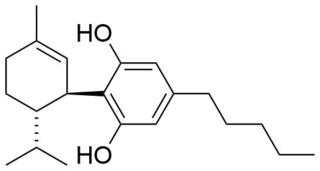
8,9-Dihydrocannabidiol is a synthetic cannabinoid that is closely related to cannabidiol (CBD) itself. that was first synthesized by Alexander R. Todd in 1940 derived from the catalytic hydrogenation of cannabidiol.

Δ-10-Tetrahydrocannabinol is a positional isomer of tetrahydrocannabinol, discovered in the 1980s. Two epimers have been reported in the literature, with the 9-methyl group in either the (R) or (S) conformation; of these, the (R) epimer appears to be the more active isomer as well as the double bond in the 10th position instead of the 9th maintaining about 30 to 40 percent the potency of delta-9-THC. Δ10-THC has rarely been reported as a trace component of natural cannabis, though it is thought to be a degradation product similar to cannabinol rather than being produced by the plant directly. However, it is found more commonly as an impurity in synthetic delta-8-THC produced from cannabidiol and can also be synthesized directly from delta-9-THC.

Hexahydrocannabinol (HHC) is a hydrogenated derivative of tetrahydrocannabinol (THC). It is a naturally occurring phytocannabinoid that has rarely been identified as a trace component in Cannabis sativa, but can also be produced synthetically by firstly acid cyclization of cannabidiol and then hydrogenation of tetrahydrocannabinol. The synthesis and bioactivity of HHC was first reported in 1940 by Roger Adams.

11-Hydroxy-Δ-8-tetrahydrocannabinol is an active metabolite of Δ8-THC, a psychoactive cannabinoid found in small amounts in cannabis. It is an isomer of 11-OH-Δ9-THC, and is produced via the same metabolic pathway. It was the first cannabinoid metabolite discovered in 1970.
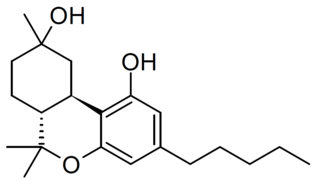
9-Hydroxyhexahydrocannabinol (9-OH-HHC) is a semi-synthetic derivative of tetrahydrocannabinol. It is formed as an impurity in the synthesis of Delta-8-THC, and retains activity in animal studies though with only around 1/10 the potency of Δ9-THC, with the 9α- and 9β- enantiomers having around the same potency.

11-Hydroxyhexahydrocannabinol is an active metabolite of tetrahydrocannabinol (THC) and a metabolite of the trace cannabinoid hexahydrocannabinol (HHC).
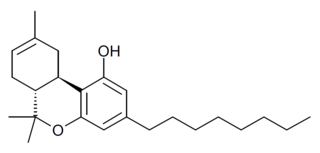
JWH-138 (THC-Octyl, Δ8-THC-C8) is a synthetic cannabinoid first synthesized by Roger Adams and studied heavily by John W. Huffman, with a Ki of 8.5nM at the CB1 cannabinoid receptor. THC-Octyl and its hydrogenated analog HHC-Octyl was synthesized and studied by Roger Adams as early as 1942.
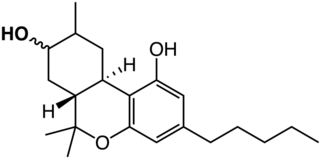
8-Hydroxyhexahydrocannabinols are active primary metabolites of hexahydrocannabinol (HHC) in animals and trace phytocannabinoids. The 8-OH-HHCs are produced in notable concentrations following HHC administration in several animal species, including humans. They have drawn research interest for their role in HHC toxicology and stereoisomeric probes of the cannabinoid drug/receptor interaction.

HHC-acetate is a semi-synthetic cannabinoid derivative which has been marketed since around 2022. It is believed to be made in a three step process from cannabidiol extracted from hemp. The legal status of hexahydrocannabinol and derivatives such as HHC-O varies between countries leading to widespread sale in some jurisdictions in Europe and the US, but in France HHC and HHC-O were banned in 2023, and HHC is already banned in several other countries. On 1st of March 2024 HHC was banned on Czech Republic.
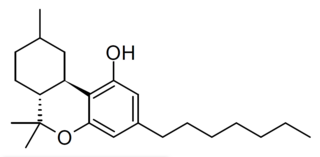
Hexahydrocannabiphorol is a semi-synthetic cannabinoid derivative which has been marketed since around 2021. It is believed to be made from the hydrogenation of tetrahydrocannabiphorol (THCP). THCP is only reported as a trace component of cannabis in 2019. HHCP was studied by Roger Adams as early as 1942.
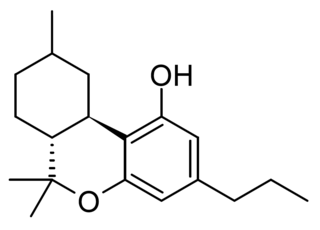
Hexahydrocannabivarin is a semi-synthetic cannabinoid derivative, the hydrogenated derivative of tetrahydrocannabivarin (THCV). It was first synthesised by Roger Adams in 1942 and produces only weak cannabinoid-like effects in animals. More recently it has been sold as an ingredient in grey-market cannabinoid products. It has been investigated for potential antineoplastic activity in vitro.
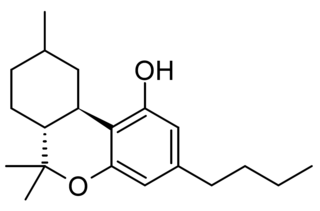
Hexahydrocannabutol is a semi-synthetic cannabinoid derivative, the hydrogenated derivative of tetrahydrocannabutol (THCB). It was first synthesised by Roger Adams in 1942 and produces only weak cannabinoid-like effects in animals. More recently it has been sold as an ingredient in grey-market cannabinoid products.

Abeo-HHC acetate is a semi-synthetic derivative of tetrahydrocannabinol, first described in the 1980s. It is synthesised from delta-11-tetrahydrocannabinol, which can be made to undergo a ring expansion reaction via a hydrazone intermediate. It is structurally similar to HHC-acetate except that the methylated cyclohexyl ring has been replaced by a cycloheptane.




















